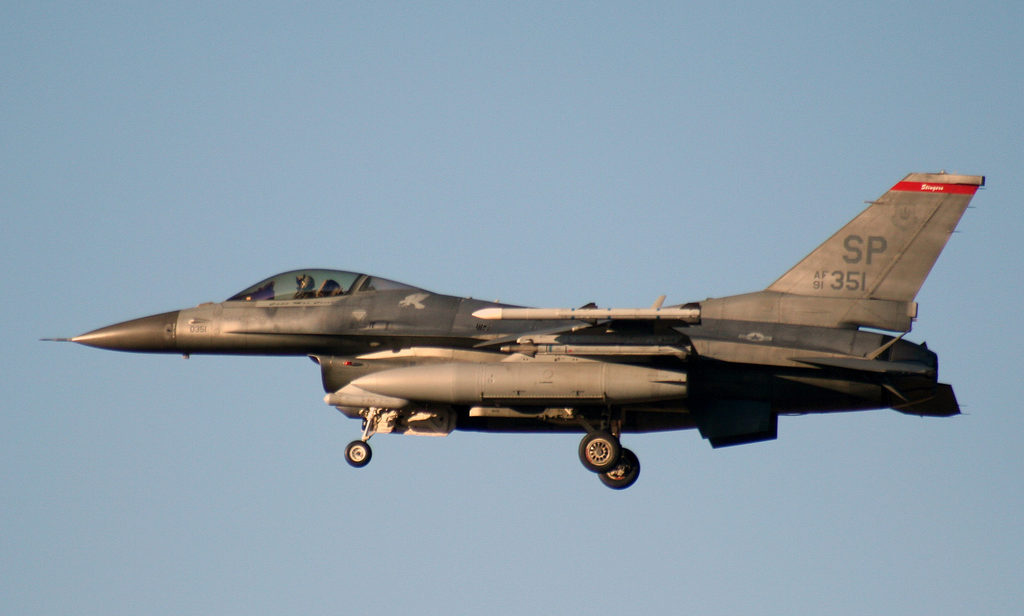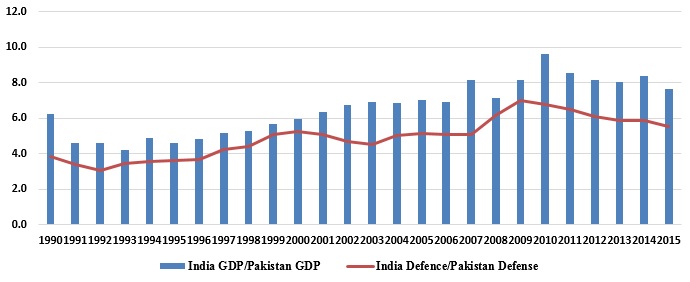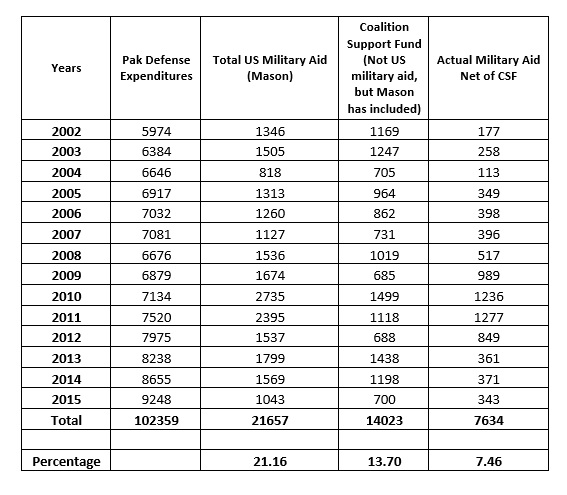
Overview
Regional instability in South Asia has serious implications, which are further intensified by the probability of nuclear exchange. Thus, an analysis of the defense posture, strategic capabilities, and priorities of India and Pakistan is crucial. The Stimson Center’s recent report by Shane Mason on military budgets in India and Pakistan is a comprehensive analysis comparing the relative positions, advantages, and trends in the military budgets, nuclear expansion, and indigenization of strategic capabilities in both countries. A comparative examination of military budgets and trends reflects strategic thinking on both sides and helps to provide an in-depth understanding of regional security imbalances.
Points of Agreement
In this report, Mason presents some compelling key points. For example, he is correct that the growth differential between India and Pakistan’s military budgets is significant, though India’s advantage diminishes as the personnel budget crowds out capitalization and modernization costs. Mason’s research here is valuable because it shows that broad budgetary comparisons have limited analytical value, compared to a more comprehensive accounting. Mason’s argument that the decline in military assistance and aid to Pakistan may affect its choice to procure advanced platforms like F-16s is also agreeable. He also makes an interesting point that Pakistan will likely face a trade-off in resource allocation between conventional and unconventional capabilities in the future. This is an important analytical inference because nuclear weapons cannot be a substitute for conventional forces in any country – including Pakistan.
Critique of the Arguments
Although I am complimentary towards the research conducted by Mason, there are a few theses in the report with which I disagree. Below are some of these points accompanied by my explanations and analysis. Where context is necessary, I reproduce the arguments, data, or graphs from Mason’s work.
“The conventional military balance will shift inexorably in India’s favor.” (10)
Although Mason is certainly correct to say that India’s relatively high levels of economic growth will likely shift the conventional military balance in India’s favor vis-à-vis Pakistan, he under-acknowledged the important point that the India-Pakistan rivalry does not exist in a vacuum. Considering the expansion of Pakistan’s already historically strong ties with China, for example, the ambitious launch of the China-Pakistan Economic Corridor (CPEC), a strict comparison between India and Pakistan’s military expenditures does not capture the full complexity of the military balance in South Asia. This is especially true if India’s strategic community emphasizes their potential to prosecute a war against China and Pakistan simultaneously, as Mason asserts in the report (17). Though this assertion seems unrealistic and strategically over-ambitious.
For example, Figure 1 indicates a growth advantage for Indian defense spending vis-à-vis Pakistan (36). This is certainly an important point to make. Yet if Indian strategic planners aim for the ability to counter China and Pakistan simultaneously, the fact that the Chinese defense spending advantage over India has become more than fourfold from 1990 to 2015, as noted in Figure 2, and with the addition of Pakistan’s defense posture, this demonstrates disproportionate strategic imbalance for India vis-à-vis China and Pakistan. Undoubtedly, the future conventional balance will be favorable for India over Pakistan. However, I would have liked to see Mason grapple a bit more with an exhaustive regional strategic analysis rather than simply the bilateral comparison.
Figure 1: India’s Relative Advantages Over Pakistan

Source: Shane Mason (2016)
Figure 2: China’s Relative Advantages Over India

Source: Asim Bashir Khan (2017) using the data source of Shane Mason (2016)
“Pakistan spends more on defense than its official estimates suggest.” (22)
The point that Pakistan’s actual military budget may be higher when certain factors highlighted in the report are accounted for seems logical. However, it is unclear whether these factors actually impact the India-Pakistan military balance. For example, the reclassification of military pension expenditures to the federal government’s budget does not seem to award Pakistan strategic advantage against India.
Furthermore, there are areas in the report where Mason seems overly skeptical about the integrity of Pakistani budgetary information. For example, Mason asserts that the budget for the Space and Upper Atmosphere Research Commission (SUPARCO), Pakistan’s civilian space agency, has not been published since 2014 (34). However, to the contrary, this information is, in fact, in the public domain. For example, Public Sector Development Program (PSDP) documents show an actual expenditure of Rs. 700 million ($6.91 million) and Rs. 1 billion ($9.61 million) for 2015 and 2016 respectively and a budgetary allocation of Rs. 2.5 billion ($23.85 million) for 2017.
“US military aid accounted for 21 percent of Pakistan’s defense budget between 2002-2015, and now accounts for less than 11 percent.” (7)
Table 1: US military aid and CSF to Pakistan (2002-2015)

Source: Asim Bashir Khan (2017) calculation based on SIPRI and Congressional Research Service data (here, here, and here)
As per my calculations using the same sources as Mason (refer Table 1), 13.7 percent of this estimate is comprised of the Coalition Support Fund, or defense department funding to reimburse Pakistan for logistical and operational support of U.S.-led military operations. This is technically not foreign assistance or aid, thus lowering the estimate of 21.16 percent American military aid to 7.46 percent. The same goes for 3.24 percent for 2016. I would have liked Mason to have explicitly added the qualification about the classification of aid with his calculated estimates.
“…[Pakistani] defense spending trends will likely increase the role of nuclear weapons in Pakistan’s defense posture…” (32).
There are at least two rationales for Pakistani nuclear competition vis-à-vis India. First, the utility of nuclear weapons is higher for a weaker nation, as they establish deterrence equilibrium. Second, low economic growth may compel Pakistan to increase the role of nuclear weapons in its defense posture, considering the fact that there are estimates that the cost of Pakistan’s conventional military is at least six times greater than the estimated cost of its unconventional capabilities
However, I would have liked for Mason to address some counterarguments that challenge this logic. For example, Pakistan’s counterterrorism efforts will require substantial conventional spending for the foreseeable future, especially considering the spate of recent terrorist attacks in Pakistan. Even Mason acknowledges that domestic counterterrorism campaigns, an uncertain relationship with Afghanistan, and, of course, the potential for clashes with India are conventional priorities (37). Thus, I would have liked to have seen him address how this logic aligns with his aforementioned prediction that nuclear weapons will take on a larger role in Pakistan’s defense posture.
Concluding Thoughts
Military budgets in India and Pakistan and trends in their respective allocations reveal important attributes of each country’s defense posture. In his analysis, Mason demonstrates intellectual scholarship on the subject. However, a mere analysis of numbers without taking into account the regional security calculus and context – specifically strengths, weaknesses, opportunities, threat analyses, and trends in defense industries – presents important limitations. In a future study, Mason or another author should address these concerns to make the analysis inclusive and consistent with the regional strategic calculus.
The views expressed are those of the author and should not be construed as representing the institutions or organizations with which he is affiliated.
***
Image: Lockheed Martin F-16 CJ, Carlos Menendez San Juan, Flickr


